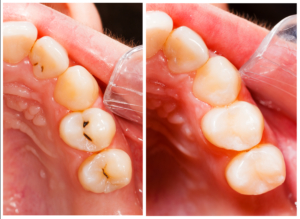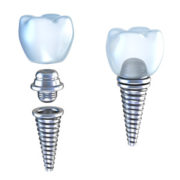The biofilm, or the complex set of microorganisms that populate our mouth and adheres to teeth and gums, if it accumulates on the gums can compromise the entire implant. New studies are developing materials that can withstand bacterial attack.
Perimplantitis: the incidence of biofilm
 Gingivitis, caries, periodontitis and peri-implantitis are caused by a patina of bacteria that adheres to the surfaces of the teeth and attacks enamel and tissues causing inflammation and infection.
Gingivitis, caries, periodontitis and peri-implantitis are caused by a patina of bacteria that adheres to the surfaces of the teeth and attacks enamel and tissues causing inflammation and infection.
Dental implants are not excluded from this problem, the contact of dental prostheses with biofilm has a strong impact on the possibility of developing peri-implantitis.
Even an infection on teeth adjacent to the implant could be harmful for the survival of the implant itself, which is why scientific research is focusing on the development of materials that can inhibit the adhesion of the bacterial load on the prosthesis.
Protect dental implants thanks to new materials
During these years, research in the dental field has shown that the microsurface of the implant influences the biofilm’s ability to adhere to the implant area.
For this reason, researchers are developing a new material that has antibacterial properties and is inert bioceramics.
It is a ceramic nanocomposite biomaterial (Al2O3 / Ce-TZP) that has all the properties necessary for osseointegration, but at the same time guarantees a reduced accumulation of bacteria in the vicinity of the implant.
Experimental study to limit the risk of peri-implantitis
In the scientific journal Dental Materials of June 2019 a research was published that compares the adherence of biofilm on different ceramic biomaterials used in implantology.
In particular, the adhesion of the following standard bacteria, very common in the oral cavity, was analyzed:
- Streptococcus oralis;
- Veillonella parvula;
- Actinomyces naeslundii;
- Fusobacterium nucleatum;
- Aggregatibacter actinomycetemcomitans;
- Porphyromonas gingivalis.
The biomaterials compared to the colonies of bacteria listed above were:
- calcium hydroxyapatite (HA);
- sandblasted sterile nanocomposite Al2O3 / Ce-TZP (material A1);
- sterile nanocomposite Al2O3 / Ce-TZP sandblasted and coated with a type of vitreous antimicrobial material (A2 materials);
- sterile nanocomposite Al2O3 / Ce-TZP sandblasted and coated with another type of vitreous antimicrobial material (A3 material).
Results
 The analysis showed that the adhesion of the bacteria was reduced in the groups in which the antimicrobial glass materials A2 and A3 were present.
The analysis showed that the adhesion of the bacteria was reduced in the groups in which the antimicrobial glass materials A2 and A3 were present.
In particular, the A3 ceramic material, with ZnO-enriched biocide glass, has a significant antibacterial effect and can be a valuable aid in the design and construction of dental implants to be used in implantology.
These studies will have to be confirmed by other studies, not only in vitro, but they represent a good start to find an important solution in the fight against peri-implantitis.















